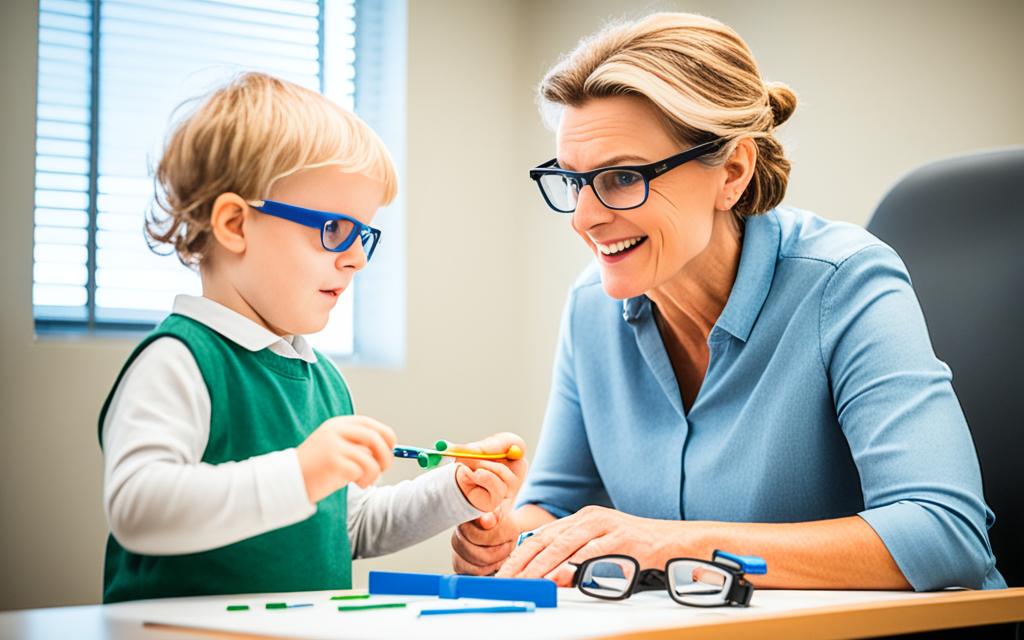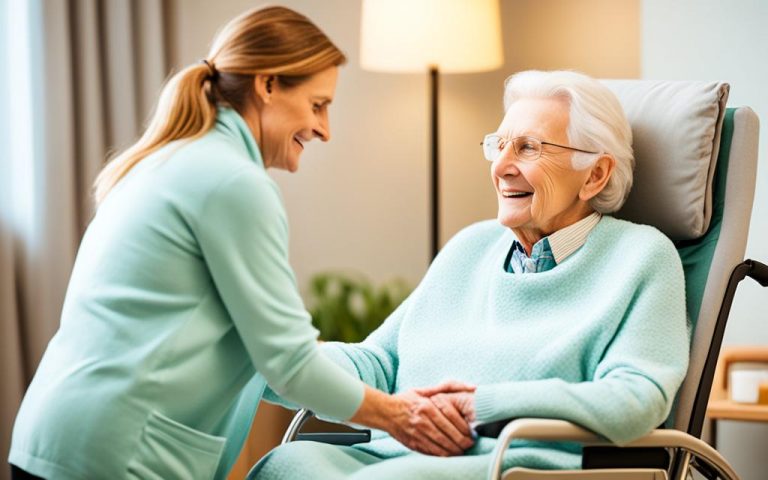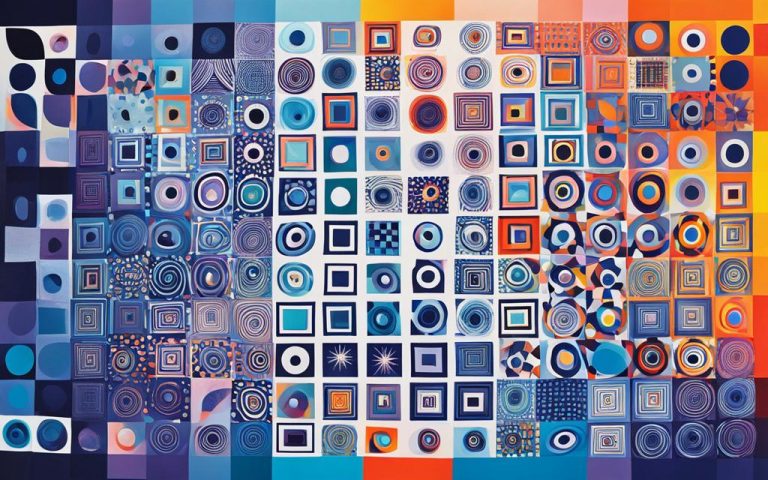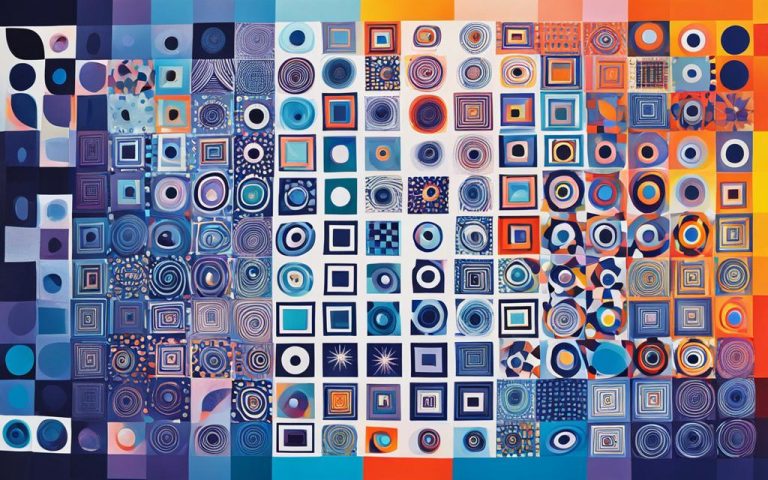Vision therapy for children with special educational needs
Special needs vision therapy helps children with unique learning challenges overcome visual difficulties. It aims to boost essential visual skills. This leads to better school work and everyday life activities. Let’s explore how this therapy can greatly improve their success in different areas.
Vision therapy is vital for kids with special educational needs. It focuses on their specific issues, aiming to enhance how they process what they see. By using different techniques and exercises, vision therapy creates a path to better learning and social interaction. It’s more than fixing their sight; it’s about showing them new ways to thrive.
Key Takeaways
- Vision therapy is tailored to improve visual skills essential for learning.
- It addresses specific visual impairments that affect children with special needs.
- Through specialized exercises, vision therapy enhances both academic and developmental progress.
- This therapy is crucial for boosting independence and self-confidence in children.
- Parents and educators should consider vision therapy as a part of a comprehensive educational plan for children with special needs.
Understanding Vision Therapy for Children with Special Educational Needs
Vision therapy has shown it can really help children with extra learning needs improve how they see the world. Understanding vision therapy helps us see how doing specific eye exercises can boost skills needed for learning. This kind of therapy is all about creating a plan just for the child, focusing on what they need most.
Vision therapy for children means doing a range of exercises to make their eyes work better. This includes making sure their eyes can focus, follow things well, and work together correctly. All of this is very important for doing well in school and being social.
- Visual Skills Training: Activities that boost eye coordination and facilitate the accurate tracking of moving objects across the child’s field of vision.
- Focusing Exercises: Tasks that improve near and far focus, pivotal for maintaining attention during classroom activities or sports.
- Binocular Skills Development: Exercises that help in developing seamless coordination between both eyes, which is essential for depth perception.
The process starts with a full check-up by a specialist to spot what eye issues the child has. Then, they use a step-by-step plan, with exercises that fit the child’s needs, to make big improvements in how the child sees things.
Vision therapy for children is more than fixing eye problems; it’s about improving the way their whole visual system works. This helps children learn better and do more, both in school and with their friends.
The Role of Pediatric Vision Therapy in Learning Development
Pediatric vision therapy is vital for children with special needs. It helps improve vision skills and cognitive growth through special activities. This strategy is designed for individual children to overcome challenges.
Improving Academic Performance through Visual Aids
Visual aids help children succeed in education by easing visual barriers. These include colored overlays and special digital tools. They make reading and learning easier, preventing eye fatigue. Hence, children find a positive space to excel academically.
The Connection between Vision Skills and Cognitive Growth
Improving vision directly aids cognitive development. Better vision processing helps kids interpret and comprehend what they see. This lays the groundwork for them to reach educational milestones and fosters overall brain growth.
Tasks like understanding shapes or tracking moving objects are easier with improved eyesight. These activities align visual and cognitive skills, driving academic success and supporting future learning.
| Visual Skill | Cognitive Benefit | Example Activity |
|---|---|---|
| Focused Vision | Improved Reading Ability | Tracing letters |
| Eye Coordination | Better Hand-eye Coordination | Bead threading |
| Visual Tracking | Enhanced Reading Comprehension | Following a moving pointer |
Pediatric vision therapy is key in solving visual problems. By addressing these issues, it ensures children do not face roadblocks in their education. This way, they can achieve their academic goals effectively.
Assessing the Need for Special Needs Vision Therapy
When helping children with special needs, it’s important to look into their vision health. Vision is crucial for learning and interacting. Problems like visual impairment can slow down a child’s progress. It’s key to spot any signs of visual impairment early on. This helps figure out the right therapy requirements for special needs children.
Identifying Signs of Visual Impairment in Children
Telling if your child has a vision problem is the first step. Watch for signs like squinting or sitting too close to screens. Also, note if they struggle to focus. If you see these signs often, it might be time for a professional check-up.
Working with Professionals to Determine Therapy Requirements
It’s vital to team up with eye care experts in figuring out a therapy plan that fits your child. These pros will test your child’s sight, eye coordination, and how well they track moving things. This data guides the therapy plan.
| Visual Skill | Assessment Technique | Common Challenges |
|---|---|---|
| Acuity | Standardized Eye Charts | Misreading, avoidance |
| Coordination | Alignment and tracking exercises | Difficulty in following moving objects |
| Perceptual Abilities | Visual-motor integration tests | Misalignment, errors in copying or tracing |
Finding and treating vision issues through personalized therapy can boost your child’s school success and happiness. A team effort in deciding on therapy requirements for special needs children lets you make well-informed choices. It guarantees your child gets the best and right care.
Tailoring Vision Therapy for Learning Disabilities
Kids with learning disabilities need vision therapy for learning disabilities that fits their unique needs. Things like dyslexia or ADHD can change how a child sees things. So, a tailored vision therapy plan is key. It looks at what they find hard and helps them build on their strengths.
Imagine a child with dyslexia. They might find it hard to follow words or put stories in order. For them, vision therapy might focus on activities to improve these skills. This could make reading easier and more fun for them. As for a child with ADHD, staying focused on visual tasks might be the challenge. Here, the goal would be to sharpen their attention and how quickly they process what they see.
- Personalized Assessments to pinpoint vision issues related to learning disabilities.
- Customized Exercise Programs aim to boost skills like eye tracking or remembering what they see.
- Regular Monitoring and Adjustments keep the therapy in tune with their changing needs, ensuring it helps their grades.
Adding vision therapy for learning disabilities to a child’s school plan can make a big difference. Each custom tailored vision therapy session boosts not just their eyesight but their self-belief and ability to learn, too.
Integrative Techniques in Visual Therapy for Kids with Special Needs
Integrative techniques in vision therapy play a key role in helping children with special needs. They mix different sensory methods to make treatments work better and last longer.
Multisensory Approaches to Vision Therapy
Multisensory vision therapy mixes various senses to make treatments more fun and useful. It combines touch, sound, and movement with vision games. This way, every child can find a method that works best for them. For example, using a balance board or sound hints with visual tasks improves their vision together.
Games and Activities that Enhance Visual Skills
Games are fun and great for learning in vision therapy. They help kids improve on things like following objects, concentrating, and remembering what they see. For instance, puzzles and matching games make kids better at seeing details. Meanwhile, computer games can change how they see things to fit their special therapy.
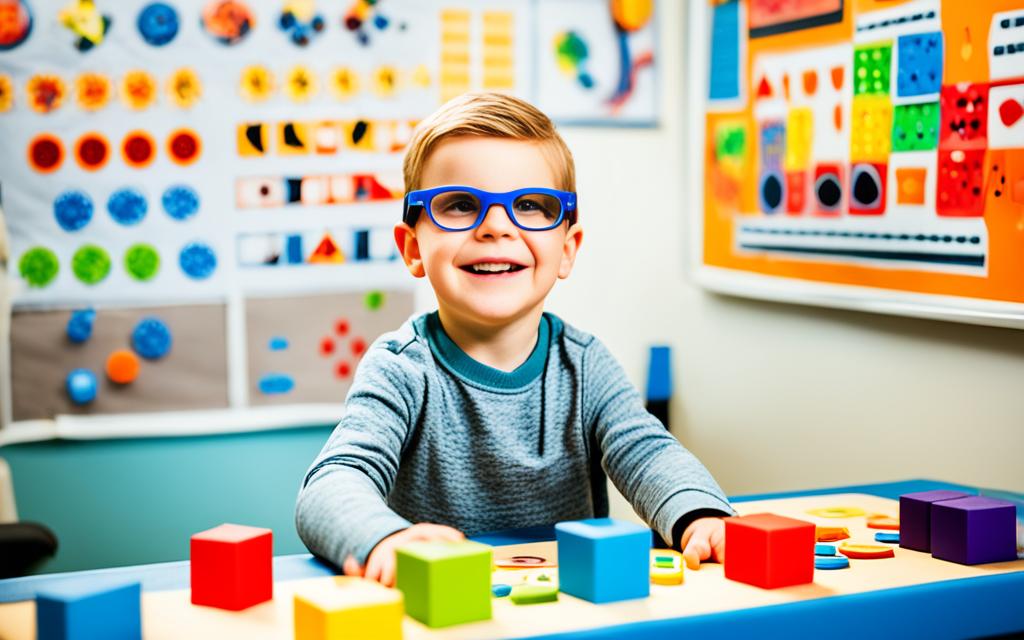
| Game Type | Visual Skill Targeted | Tool Used |
|---|---|---|
| Memory Matching | Visual Memory | Cards |
| Puzzle Assembly | Visual-Spatial Skills | Physical Puzzles |
| Interactive Digital Games | Reaction Time and Focus | Computer Software |
Adding multisensory parts to vision therapy makes it more engaging and fits different learning styles. These tools help therapists give more personalized and useful help. This results in big steps forward in how well these children see.
Key Benefits of Children’s Vision Therapy
Vision therapy changes lives, not just vision. For kids, the benefits of vision therapy go beyond the classroom. It improves their social and school life. Let’s see how targeted vision therapy does this.
Boosting Self-Esteem and Social Skills
Vision therapy helps kids feel better about themselves and improves their social skills. Dealing with vision problems can make them feel left out. This affects how they connect with others. Vision therapy helps them learn important skills like looking people in the eye. It also makes them better at reading faces and understanding space. This makes kids more confident and better at making friends.
Long-term Advantages of Early Vision Intervention
Early vision therapy is key for kids to grow well and do well in school. By spotting and fixing vision issues early, it lessens the chance of learning problems. So, these kids are ready to do their best in school. This lays a strong foundation for their studies.
Starting vision therapy early has big benefits. It’s not just about doing well in school. It also makes kids lifelong learners who feel good about themselves and connect well with others. The chart below shows how:
| Aspect of Development | Impact of Early Vision Intervention |
|---|---|
| Academic Performance | Significant improvements in reading, writing, and math |
| Social Development | Enhanced social interaction and participation in group activities |
| Self-Esteem | Increased confidence leading to improved school and social engagement |
The benefits of vision therapy, especially when started early, can be life-changing. By addressing eye problems early, we help kids shine in everything they do. It shows how important specialized eye care is for a child’s growth.
Therapy Techniques for Visually Impaired Children
When we talk about vision therapy for visually impaired kids, the goal is to boost their visual skills. This helps them lead more independent lives. It’s crucial to look at various therapy methods. They not only unlock the child’s full potential but also make them feel more independent.
Orientation and Mobility Training is key. It shows kids how to find their way and move safely alone. Using Visual Aids like magnifiers and sound devices makes the most of the vision they have. And Adaptive Strategies change the surroundings to fit the kid’s needs.
- Orientation and Mobility Training: This teaches visually impaired children how to orient themselves in various environments and move safely and independently.
- Visual Aids: Tools such as magnifiers, tactile systems, and auditory aids help maximize the use of residual vision.
- Adaptive Strategies: Techniques that adjust the learning environment to meet the specific visual requirements of the child.
To succeed, it’s vital to know each child’s exact needs. The therapy must be personalized, focusing on everyday life and social skills.
| Technique | Benefits | Examples |
|---|---|---|
| Orientation and Mobility | Increases independence, improves spatial awareness | White canes, GPS devices |
| Visual Aids | Enhances remaining vision, assists in daily activities | Telescopic glasses, electronic readers |
| Adaptive Strategies | Customizes learning approaches, improves educational outcomes | Braille materials, audiobooks |
Developmental Vision Therapy for Special Needs
As pediatric health care changes, developmental vision therapy becomes crucial for children with special needs. It uses the power of neuroplasticity and vision training.
Understanding Neuroplasticity and Vision Training
Neuroplasticity is key to how developmental vision therapy helps. It lets the brain reorganize by making new connections. This process is vital in therapy. Exercise and training for the eyes boost this change, improving how the brain sees, learns, and does daily tasks.
Customized Plans for Individual Needs
For children with visual issues, customized therapy plans are carefully made. Each plan focuses on the child’s unique needs and visual problems. This personal approach makes therapy more effective.
These plans have special exercises and tasks. They change based on how the child improves. This tailored approach is what makes developmental vision therapy work well for special needs.
| Neuroplasticity Techniques | Customization Aspects |
|---|---|
| Visual Tracking Enhancement | Personalised Exercise Patterns |
| Sensory Integration Training | Adjustments Based on Sensory Responses |
| Neural Rebalancing | Continuous Monitoring and Feedback |
In the end, mixing neuroplasticity with a personal touch respects each child’s needs. It helps them fully explore and understand the visual world around them.
Visual Treatment for Children with Learning Challenges
Adapting therapy for kids with learning disorders is key. This ensures visual treatment works well for them. Custom strategies help meet every child’s unique needs. This improves their learning.
Adapting Therapy to a Variety of Learning Disorders
Visual treatment must fit the kind of learning disorder a child has. For instance, it could be dyslexia or attention deficit disorder.
Using a custom approach makes therapy effective. It gives tools that help with each child’s learning struggles.
At-home Exercises to Support Therapy Sessions
Doing exercises at home supports what kids learn in therapy. These exercises are easy but boost how well kids understand what they see.
| Learning Disorder | Therapy Adaptation | Recommended At-Home Exercise |
|---|---|---|
| Dyslexia | Visual Sequencing Techniques | Word and Picture Matching Games |
| Attention Deficit | Concentration Building Drills | Color-by-Number Activities |
| Sensory Processing Disorder | Multi-Sensory Integration | Texture Identification Exercises |
Doing these home exercises often can really help. This makes visual treatments more effective for specific learning challenges. It boosts kids’ learning and growth.
Collaborating with Schools to Support Vision Therapy for Children with Special Educational Needs
Working with schools is key to making vision therapy effective for kids with special needs. It creates a team with healthcare workers, teachers, and school staff. Together, they ensure the child’s learning is just right for their eye care needs. This makes learning a better and tailored experience for these children.
Creating a Supportive Learning Environment
Schools work to make a friendly place for kids in vision therapy. They do this by changing the lights, the classroom layout, and giving special tools. These things help kids learn and make friends better at school.
Teacher Involvement in Vision Care Plans
It’s really important for teachers to be part of the child’s vision care. They can help the therapy fit into the school day. This makes sure the therapy helps the child’s education.
Teachers should learn a bit about vision problems and their treatments. This makes them a big part of making sure the therapy works well for the child.
All this work with schools and teachers makes a big difference. It helps kids with vision problems do better at school and have a happier life.
Conclusion
Vision therapy plays a key role in helping special needs kids. It greatly improves their eyesight and overall development. By meeting each child’s unique needs, this therapy helps them see better and learn more effectively.
Vision therapy is more than eye exercises. It’s a custom approach to each child’s visual challenges. It also supports kids in feeling more at ease while learning. Each session guides a child closer to reaching their full potential.
In closing, vision therapy is extremely valuable to children with special needs. It’s essential for parents and teachers to know about and use this therapy. With the right strategies and ongoing effort, vision therapy can boost a child’s vision and success in education and life.
FAQ
What is vision therapy for children with special educational needs?
Vision therapy helps kids with special educational needs get better at using their eyes. It uses special activities and exercises. These aim to improve how the eyes work together and focus.
How does vision therapy work?
Vision therapy is a step-by-step way to make your eyes work better. It’s not surgery, and it’s all about you. It gets rid of problems and makes your eyes stronger so you can learn better and grow.
What is the role of pediatric vision therapy in learning development?
Pediatric vision therapy is key for kids with special needs to learn. It helps fix eye issues and make learning easier. By making how they see better, learning gets a lot smoother.
How can I assess the need for special needs vision therapy?
Look for signs like trouble reading or lots of headaches. These show your child might need vision therapy. Talk to eye doctors and therapists. They can help figure out what your child needs to see better.
Can vision therapy be tailored to address learning disabilities?
Yes, vision therapy can help kids with different learning issues. It’s designed just for them. By focusing on the child’s needs, it helps improve how they learn and see things.
Are there integrative techniques used in vision therapy for kids with special needs?
Yes, vision therapy uses different techniques to make it work best. It might include games and activities. This makes learning to see better more fun and effective.
What are the key benefits of children’s vision therapy?
Vision therapy does more than just improve how kids see. It boosts their confidence and makes them better at making friends. Plus, it can prevent future learning problems by helping early.
What therapy techniques are used for visually impaired children?
Therapy for these kids helps them make the most of what they can see. It might use special tools or teach them how to move around safely. This makes them more independent.
What is developmental vision therapy for special needs?
Developmental vision therapy helps kids with special needs see better by training their brains. It uses special exercises to improve eyesight. Each child gets a plan that’s just right for them.
How is visual treatment tailored for children with learning challenges?
Visual treatment is made to fit each child’s learning issue. It might work on reading problems or trouble focusing. Doing exercises at home can make therapy even better.
How can schools collaborate to support vision therapy for children with special educational needs?
Schools can help a lot by understanding a child’s vision issues. They should adjust things to help the child learn better. Teachers and vision therapists should work together for the best results.

